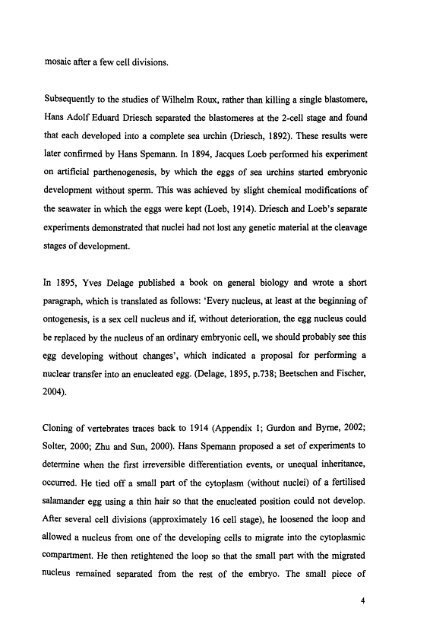-210 Nottingham - Nottingham eTheses - The University of Nottingham
-210 Nottingham - Nottingham eTheses - The University of Nottingham
-210 Nottingham - Nottingham eTheses - The University of Nottingham
You also want an ePaper? Increase the reach of your titles
YUMPU automatically turns print PDFs into web optimized ePapers that Google loves.
mosaic after a few cell divisions.<br />
Subsequently to the studies <strong>of</strong> Wilhelm Roux, rather than killing a single blastomere,<br />
Hans Adolf Eduard Driesch separated the blastomeres at the 2-cell stage and found<br />
that each developed into a complete sea urchin (Driesch, 1892). <strong>The</strong>se results were<br />
later confirmed by Hans Spemann. In 1894, Jacques Loeb performed his experiment<br />
on artificial parthenogenesis, by which the eggs <strong>of</strong> sea urchins started embryonic<br />
development without sperm. This was achieved by slight chemical modifications <strong>of</strong><br />
the seawater in which the eggs were kept (Loeb, 1914). Driesch and Loeb's separate<br />
experiments demonstrated that nuclei had not lost any genetic material at the cleavage<br />
stages <strong>of</strong> development.<br />
In 1895, Yves Delage published a book on general biology and wrote a short<br />
paragraph, which is translated as follows: `Every nucleus, at least at the beginning <strong>of</strong><br />
ontogenesis, is a sex cell nucleus and if, without deterioration, the egg nucleus could<br />
be replaced by the nucleus <strong>of</strong> an ordinary embryonic cell, we should probably see this<br />
egg developing without changes', which indicated a proposal for performing a<br />
nuclear transfer into an enucleated egg. (Delage, 1895, p. 738; Beetschen and Fischer,<br />
2004).<br />
Cloning <strong>of</strong> vertebrates traces back to 1914 (Appendix 1; Gurdon and Byrne, 2002;<br />
Solter, 2000; Zhu and Sun, 2000). Hans Spemann proposed a set <strong>of</strong> experiments to<br />
determine when the first irreversible differentiation events, or unequal inheritance,<br />
occurred. He tied <strong>of</strong>f a small part <strong>of</strong> the cytoplasm (without nuclei) <strong>of</strong> a fertilised<br />
salamander egg using a thin hair so that the enucleated position could not develop.<br />
After several cell divisions (approximately 16 cell stage), he loosened the loop and<br />
allowed a nucleus from one <strong>of</strong> the developing cells to migrate into the cytoplasmic<br />
compartment. He then retightened the loop so that the small part with the migrated<br />
nucleus remained separated from the rest <strong>of</strong> the embryo. <strong>The</strong> small piece <strong>of</strong><br />
4
















